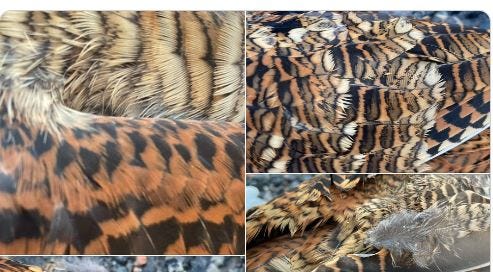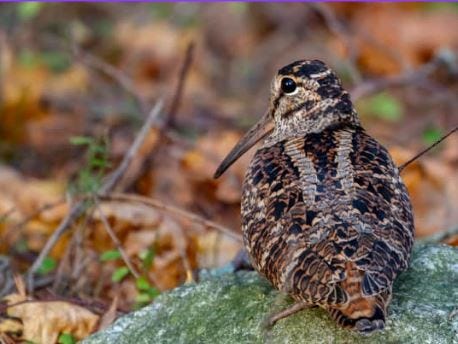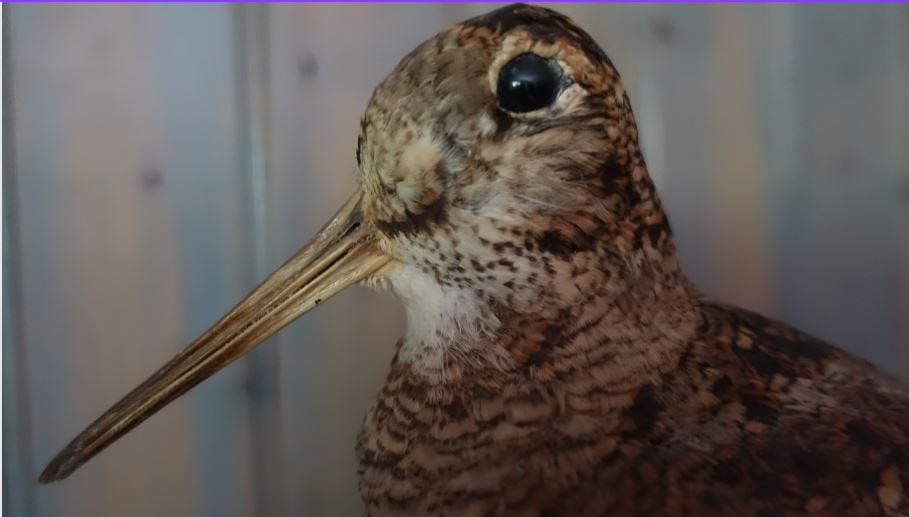Here in the Scottish Highlands, where myths dance with the mist, there exists an avian enigma that is as much a part of the landscape as the heather and the thistle, you may have seen it - but you also may not have, as these birds are well hidden.
Resembling a hearty loaf of Scottish bread in size, with a beak sharp enough to rival a Hogwarts quill, they have long captivated the imagination of locals and visitors alike. This is the Woodcock (Scolopax rusticola).
The Unique Appearance and Behaviour of the Woodcock
Woodcocks have a brown, mottled plumage and are masters of camouflage. This plumage is not just a fashion statement; it's a survival mechanism, allowing them to nest and rest undetected by predators and overzealous birdwatchers. But it’s not just their looks that make these birds special.
The woodcock's 'roding' display, a twilight ritual involving straight-line flights and grunting calls, is a spectacle integral to a Highland evening. It's during these displays that the woodcock is most detectable.
Unfortunately their peculiar penchant for night-time antics also leads them, like feathery daredevils, to play chicken with oncoming traffic, adding a touch of adrenaline to otherwise serene Highland drives.
Ecological Niche and Adaptations
Contrary to what one might expect of wading birds, woodcocks favour the damp, earthy environment of the Highland woodlands. Here, amidst the leaf litter and moist soil, their long, sensitive beaks become invaluable tools, unearthing worms. This slender, sensitive instrument is a marvel of avian engineering, capable of delving deep into the soil with the precision of a surgeon’s scalpel. The woodcock's adaptation to woodland habitats, particularly their nocturnal foraging habits in adjacent fields, highlights their unique ecological niche.
Their eyes, positioned on the sides of their heads, provide a near 360-degree vision. This means they can see everything from the fox sneaking up behind them to that tasty insect contemplating life on a nearby leaf. A useful adaption given they nest on the ground, laying typically 4 eggs per brood.
Migration Patterns
In winter, the Highlands experience a significant influx of woodcocks from the European continent, swelling the local population by up to five times. Ringing and tracking studies have revealed that some of these winter visitors originate from as far east as Russia, underscoring the international significance of the species. During these colder months, areas in North Ireland and North-West Scotland become hotspots of woodcock abundance, transforming the region into a sort of woodcock holiday resort.
There's an old saying that when migrant Woodcock arrive early in autumn, it heralds a bountiful harvest, particularly if these birds linger until spring. Coastal sightings of woodcock often align with the morning following the full moon in late October or November, a phenomenon traditionally referred to as a "woodcock moon”.
Conservation Concerns
Despite their elusive nature, woodcocks are not immune to ecological challenges. Atlas data points to a long-term decline in the breeding population. The core data on changes in their status primarily come from periodic surveys, highlighting the need for ongoing conservation efforts.
According to the British Ornithological Society, the woodcock's breeding range has seen a significant contraction, now standing at less than half of what it was in the 1960s. The 2013 Woodcock Survey painted a sobering picture of their plight, revealing a significant decline in breeding numbers and range since 2003. The survey suggested that the survival of these enigmatic birds is closely linked to the presence of large tracts of continuous woodland, highlighting the importance of habitat conservation.
The woodcock's addition to the UK Birds of Conservation Concern Red List in 2015 underscores the urgency of these efforts. This designation, a result of the bird's long-term decline in breeding numbers and range, is a call to action for all who cherish the natural wonders of the Highlands.
Current Conservation Efforts
In 2023, a National Woodcock Survey by British Trust for Ornithology (BTO) and the Game & Wildlife Conservation Trust (GWCT) are conducting detailed surveys to understand better the woodcock's habitat needs. This is set to provide fresh insights into the population and range of these birds, as well as their habitat preferences. This survey was not just for the scientists; bird enthusiasts and nature lovers have also been playing a crucial role. By signing up and selecting a survey square of their region, volunteers have been contributing to a better understanding of the woodcock's needs, helping shape future conservation strategies.
The causes behind the woodcock's decline are thought to be varied and complex. Factors such as recreational disturbance and its designation as a quarry species, the drying out of woodlands, overgrazing by deer, declining woodland management, and the maturation of new plantations have all been suggested. Conservation actions focusing on controlling deer populations and increasing the scrub and field layers in woodlands are believed to benefit the woodcock significantly.
Keep your eyes peeled
In the world of birds, the woodcock may not be the peacock with its sapphire feathers, nor the eagle with its regal bearing, but in the Scottish Highlands, they are celebrities in their own right.
They remind us that nature has a sense of humour. So, next time you're out on a Highland road at dusk, watch for the woodcock's impromptu roadside performances. And remember, each sighting is a wonderful glimpse into a world where the wild heart of Scotland still beats strong—a world that we must strive to preserve for generations to come.







